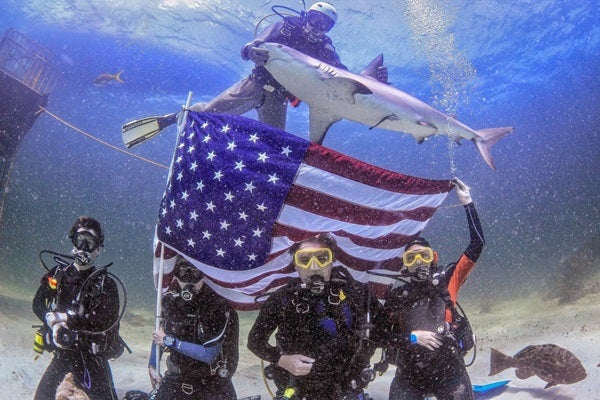Seen from above, the Bahama Banks are a spectacular sight. As I write this, I’m looking out the window of an airplane and taking it in. Ripples of color paint the ocean for miles on end. Bands of light green and blue give way to deeper turquoise. Beneath crystal clear water, undersea sand dunes formed by ocean currents stretch across vast expanses of flat-bottomed shallows. The Bahama Banks are the submerged top of the Bahama Archipelago, limestone grown by corals millimeters at a time over the past 100 million years or so.
But suddenly, the pastels give way to sharp-edged, soul-swallowing blue as dark as any the seas have to offer. This is the Tongue of the Ocean, a trench that drops as much as 14,000 feet to the ocean floor.
The boundary of the Tongue of the Ocean is every bit as abrupt up close as it appears to be from 30,000 feet. I spent the past week with family scuba diving on the living reefs that built these islands. Some of the most spectacular of those reefs live right along the edge of the ocean trench where waves and currents keep nutrient-rich waters agitated, providing food for corals.
Even after three decades as an avid diver, I still find it eerie to be at the edge of the reef when the flat bottom abruptly gives way, becoming a vertical wall, covered in life. I can follow that wall down for about 100 feet before I have to stop. My dive computer reminds me that I can’t stay here long. If I do, the pressurized nitrogen in the air that I am breathing will turn my blood into deadly bubbles when I return to the surface. But the wall itself continues to plummet, vanishing into the depths. This is the abyss.
If the dive computer’s warning is not enough of a reminder that I am an interloper here, a large dark shadow materializing out of the gloom adds emphasis. It is far from the first time that I’ve encountered a shark under water. This is a Caribbean reef shark, an opportunistic feeder with a preference for an easily scavenged meal over the need to hunt.
Sharks here are accustomed to divers. A local dive shop features pictures of celebrities who have come to watch divers hand-feed sharks. We did a couple of those dives, and they are spectacular to see, but they are controlled. There is something compelling about having a shark check me out, just the two of us in open water, passing by closely enough to overfill the field of view of a wide-angle lens.
Sharks patrolling a reef usually have a slow, relaxed motion. Work at it and you can swim alongside for a time. But don’t imagine that means anything. As this shark swims past, something catches its attention. With no warning it flicks its tail, and before I fully register the change in behavior, the shark is easily 30 feet away and moving fast.
I think to myself about the evolutionary arms race that gifted the ancient and efficient shark with such bursts of speed, while also giving the fish that attracted its attention a fair chance of escape. How many countless billions of creatures lived or died over the millions of years that it took to evolve reactions so attuned to this environment?
Evolution offers me no such advantages here. My survival depends on training and the technology that I carry on my back. So why am I so at peace?
What I feel here calls to mind the first time that I looked at the rings of Saturn through a 3-inch refractor, or saw protozoans in a drop of pond water under a microscope. It is what I felt as a kid working on a wheat farm when at the end of the day I would shut down the tractor, lie down on the ground, and look at the spectacularly dark skies of northwestern Oklahoma.
What I feel hanging there with a shark in that column of saltwater is a sense of wonder. It is a sense of awe. It is a delicious blend of pure aesthetic experience heightened by intellectual understanding of the patterns and processes that shape the world.
And I remember why I am a scientist.











